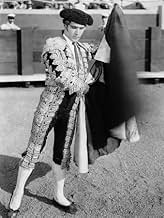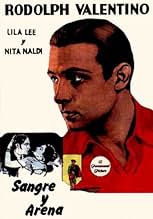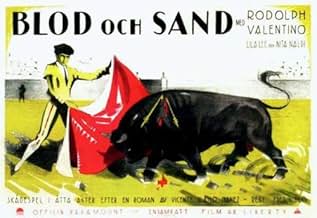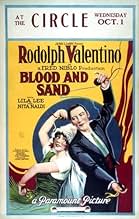VALUTAZIONE IMDb
6,3/10
1619
LA TUA VALUTAZIONE
La vita familiare e sociale di un torero è minacciata quando inizia una relazione proibita.La vita familiare e sociale di un torero è minacciata quando inizia una relazione proibita.La vita familiare e sociale di un torero è minacciata quando inizia una relazione proibita.
- Regia
- Sceneggiatura
- Star
- Premi
- 1 vittoria in totale
Rudolph Valentino
- Juan Gallardo
- (as Rodolph Valentino)
Rosa Rosanova
- Angustias
- (as Rose Rosanova)
W.E. Lawrence
- Fuentes
- (as William Lawrence)
Michael Dark
- Doña Sol's New Lover
- (non citato nei titoli originali)
Recensioni in evidenza
I've watched "Blood and Sand" several times; I own the DVD. With every viewing I notice some new subtle nuance in the under played gestures of Valentino. In the big seduction scene between Valentino and the voluptuous Nita Naldi, she sits at a harp, delicately playing, with her back to Valentino. He walks up behind her chair, clearly aroused, and he begins to seductively stroke the chair! This is so under played and yet so visually compelling and sensuous.It is so unlike the melodramatic rather hystrionic aesthetic so often found in films from this period. Valentino's restraint throughout the film's more emotional moments is compelling; his subtlety pulls the viewer intimately inward.True, the bull fighting scenes leave a bit to be desired. They are the result of some rather choppy editing and sadly come off looking peculiar,even humorous at times. Somehow Valentino pulls it off, his graceful movements, his quiet emotions, his compelling sensuality more than make up for the lack of authenticity in the bullring.
I just watched the 1941 Tyrone Powers remake of this film and enjoyed it very much, and reflected on American's fascination with the corrida during a couple critical time periods. It was the perfect time to watch this Rudolph Valentino (1922) version which is also a retelling of the book by Vincente Balasco Ibanez. This is the first Valentino film that I have seen and having watched many other silent films, I can see why Valentino was such a heartthrob. He really captures your attention and unlike other stars of the era was not overly campy to get his emotions across.
The general story is still the same, poor boy aspires to be a toreador, marries girl next door, then as he achieves fame and good fortune is noticed and subsequently seduced by fickle wealthy woman...who doesn't truly care for him and moves on to her next shiny plaything, leaving our toreador Juan to pick up the pieces.
Both films end the same way...even with the concept that the bull isn't the beast but the crowd of the corrida is the never satisfied beast. I will say the 1941 film version seemed to glorify or romanticize the bullfighting much more than the 1922 version that just kind of showed it as is.
I really enjoyed this Valentino take. In fact, I think I preferred it to Tyrone Power's film. That may be an unpopular view, but there was so much packed in to the 1922 version that made it feel like you were getting a real look into the past. More emphasis was put on the story...and less on romanticizing bullfighting as a sport. So many great details gave authenticity to the scenes...like when they are in a pub it is just thick with smoke as the crowd is smoking and drinking while the Gypsies perform flamenco. In Dona Sol's seduction pad behind the action their is a small pillar with incense smoke rising above the action...have you ever thought about how smelly those homes were with no indoor plumbing, lack of bathing, etc...yep, people with money burned incense to mask the bad smells. And the mantillas! The veils, the hairstyles...someone tried to do a nice job with giving it the look and feel of Seville.
I liked the bandit character in this version with a parallel rising from poverty with bravery story.
My only complaint is the half naked house servant in Dona Sol's employ...that seemed out of place and like something you would only see in a Hollywood theatrical production.
I have read some reviews complaining of the overt seduction...but I preferred that, it gave me more sympathy for Juan who seemed to really love Carmen. In the Tyrone version...as a woman I had a lot less sympathy for Juan as it seemed like it was all instigated from him, "pretty girl must have". As a woman, I like to think men have more willpower...but maybe they don't. (Please don't burst my bubble.)
If you are a silent film fan, I think this is a must see. If you are interested in bullfighting...I think this is a worthy watch and if you are interested in the 1920's you should definitely watch this. Highly recommend.
The general story is still the same, poor boy aspires to be a toreador, marries girl next door, then as he achieves fame and good fortune is noticed and subsequently seduced by fickle wealthy woman...who doesn't truly care for him and moves on to her next shiny plaything, leaving our toreador Juan to pick up the pieces.
Both films end the same way...even with the concept that the bull isn't the beast but the crowd of the corrida is the never satisfied beast. I will say the 1941 film version seemed to glorify or romanticize the bullfighting much more than the 1922 version that just kind of showed it as is.
I really enjoyed this Valentino take. In fact, I think I preferred it to Tyrone Power's film. That may be an unpopular view, but there was so much packed in to the 1922 version that made it feel like you were getting a real look into the past. More emphasis was put on the story...and less on romanticizing bullfighting as a sport. So many great details gave authenticity to the scenes...like when they are in a pub it is just thick with smoke as the crowd is smoking and drinking while the Gypsies perform flamenco. In Dona Sol's seduction pad behind the action their is a small pillar with incense smoke rising above the action...have you ever thought about how smelly those homes were with no indoor plumbing, lack of bathing, etc...yep, people with money burned incense to mask the bad smells. And the mantillas! The veils, the hairstyles...someone tried to do a nice job with giving it the look and feel of Seville.
I liked the bandit character in this version with a parallel rising from poverty with bravery story.
My only complaint is the half naked house servant in Dona Sol's employ...that seemed out of place and like something you would only see in a Hollywood theatrical production.
I have read some reviews complaining of the overt seduction...but I preferred that, it gave me more sympathy for Juan who seemed to really love Carmen. In the Tyrone version...as a woman I had a lot less sympathy for Juan as it seemed like it was all instigated from him, "pretty girl must have". As a woman, I like to think men have more willpower...but maybe they don't. (Please don't burst my bubble.)
If you are a silent film fan, I think this is a must see. If you are interested in bullfighting...I think this is a worthy watch and if you are interested in the 1920's you should definitely watch this. Highly recommend.
Rudolph Valentino was every woman's dream, except after he ate his favorite Italian meal for lunch, heavily laden with a good dose of spicy garlic. His breath, needless to say, had the lingering smell of an undesirable odor. Lina Lee, who played his love interest Carmen in August 1922's "Blood and Sand," after getting a whiff during a lingering kiss on set, insisted their love scenes be filmed before lunch.
The story of Juan Gallardo, based on Vincente Ibanez's 1909 of the same name, could easily act as a parallel to the actor playing the matador, Valentino, as well as his life. Juan is a poor village boy much like the actor when he immigrated to the United States. In the book the young man emerges despite discouraging words from his parents as one of the greatest matadors in Spain. He marries his village childhood sweetheart, Carmen, after achieving fame in the bullring. While exhibiting on the road, however, he falls in love with a conniving seductive, yet shallow, wealthy widow. Guilt ridden about the affair, he becomes reckless in the arena.
"Blood and Sand" was filmed in the middle of the actor's involvement with his girlfriend, Natacha Rambova, while still legally married to his first wife, despite their divorce filings. Under contract with the Famous Players-Lasky Studios, Valentino was upset with their switch in shooting locales after they originally planned to film in Spain. The actor was anticipating visiting his relatives in Italy around breaks in production after a 10-year absence from seeing them. He also became unhappy with his mediocre salary despite his employers enjoying a bonanza at the box office with his every movie. With all the conflict and personal tribulations, "Blood and Sand," Valentino's favorite movie he appeared in, was the third highest grossing film of the year, piling on the money the studio was making off their prized popular actor.
For Mary Pickford, among the many critics who loved the movie, said "In my judgement it was the best thing he has done. It is one of the few pictures I have been able to sit through twice and enjoy the second time more than the first."
"Blood and Sand" also proved to be a pivotal picture for Dorothy Azner. Jumping into the movie business soon after she soured from becoming a doctor, she received a job with Paramount through Cecil's brother William DeMille's guidance. Typing scripts, Azner soon learned the art of film editing. She drew the assignment to edit "Blood and Sand," where she saved the studio thousands of dollars by obtaining stock footage of actual bullfights to intercut with the shots of Valentino and other actors acting as matadors in the ring. She even assisted director Fred Niblo (not Valentino's choice as a director, another point of contention he had with the studio) in the bullfighting scenes, positioning the actors to coincide with her stock footage. Soon after her highly praised job as an editor, Azner was able to leverage her talents to become a very successful movie director.
The story of Juan Gallardo, based on Vincente Ibanez's 1909 of the same name, could easily act as a parallel to the actor playing the matador, Valentino, as well as his life. Juan is a poor village boy much like the actor when he immigrated to the United States. In the book the young man emerges despite discouraging words from his parents as one of the greatest matadors in Spain. He marries his village childhood sweetheart, Carmen, after achieving fame in the bullring. While exhibiting on the road, however, he falls in love with a conniving seductive, yet shallow, wealthy widow. Guilt ridden about the affair, he becomes reckless in the arena.
"Blood and Sand" was filmed in the middle of the actor's involvement with his girlfriend, Natacha Rambova, while still legally married to his first wife, despite their divorce filings. Under contract with the Famous Players-Lasky Studios, Valentino was upset with their switch in shooting locales after they originally planned to film in Spain. The actor was anticipating visiting his relatives in Italy around breaks in production after a 10-year absence from seeing them. He also became unhappy with his mediocre salary despite his employers enjoying a bonanza at the box office with his every movie. With all the conflict and personal tribulations, "Blood and Sand," Valentino's favorite movie he appeared in, was the third highest grossing film of the year, piling on the money the studio was making off their prized popular actor.
For Mary Pickford, among the many critics who loved the movie, said "In my judgement it was the best thing he has done. It is one of the few pictures I have been able to sit through twice and enjoy the second time more than the first."
"Blood and Sand" also proved to be a pivotal picture for Dorothy Azner. Jumping into the movie business soon after she soured from becoming a doctor, she received a job with Paramount through Cecil's brother William DeMille's guidance. Typing scripts, Azner soon learned the art of film editing. She drew the assignment to edit "Blood and Sand," where she saved the studio thousands of dollars by obtaining stock footage of actual bullfights to intercut with the shots of Valentino and other actors acting as matadors in the ring. She even assisted director Fred Niblo (not Valentino's choice as a director, another point of contention he had with the studio) in the bullfighting scenes, positioning the actors to coincide with her stock footage. Soon after her highly praised job as an editor, Azner was able to leverage her talents to become a very successful movie director.
"Blood and Sand" tells us many times how cruel and dangerous it believes bullfighting to be, but in terms of what it actually shows us, it seems far more interested in the romantic qualities of Rudolph Valentino and his larger-than-life love triangle.
Valentino gives a legitimately good performance, but even the love story loses some of its immediacy from the fact that "Blood and Sand" takes its subject at some distance, periodically stepping back and focusing on the scholar who foreshadows the matador's end. This also allows some of the characterization to go without being fully realized. When all is said and done it is neither believable as an anti-bullfighting film nor totally involving as a story of a love triangle, but some of the elements, including the performances and some excellent symbolic imagery, are well realized.
Valentino gives a legitimately good performance, but even the love story loses some of its immediacy from the fact that "Blood and Sand" takes its subject at some distance, periodically stepping back and focusing on the scholar who foreshadows the matador's end. This also allows some of the characterization to go without being fully realized. When all is said and done it is neither believable as an anti-bullfighting film nor totally involving as a story of a love triangle, but some of the elements, including the performances and some excellent symbolic imagery, are well realized.
BLOOD AND SAND is one of those rare movies where the remake is actually much better--and this isn't because the remake was a sound movie and this one was silent. The problem is that the original Valentino film was a very traditional morality play that tried to please the more conservative film viewer of the day and ended up being rather heavy-handed and lacked depth. So, despite this being a film by America's most loved male sex symbol of the day, it is very pro-family and discusses the evils of extramarital affairs in a very obvious and superficial manner (the remake is slower paced and less preachy). This is odd, by the way, when you compare this film with two of Valentino's other famous performances. In THE SHIEK, there is a lot of sexual tension and the film is pretty racy for its day, as was THE FOUR HORSEMEN OF THE APOCALYPSE (which even included some nudity). It really is interesting how none of these films represent the average viewer--the movie is either anti-sex (like BLOOD AND SAND) or very pro-sex (like the other two). A truly interesting dichotomy.
Lo sapevi?
- QuizThe film's editor was Dorothy Arzner, who would later go on to become Hollywood's first female director. Arzner impressed the producers by cannily interspersing stock bull-fighting footage with shots of Rudolph Valentino to make it look like the actor was actually in the ring with real bulls. This was quite a progressive technique in its day.
- BlooperThe mountain bandit who is one of the principal supporting characters is an anachronism; the Guardia Civil did away with their kind during the late 19th century.
- Citazioni
Juan Gallardo: We spread our capes for your amusement and most generous alms.
- ConnessioniEdited into Michael Blanco (2004)
I più visti
Accedi per valutare e creare un elenco di titoli salvati per ottenere consigli personalizzati
- How long is Blood and Sand?Powered by Alexa
Dettagli
Botteghino
- Lordo Stati Uniti e Canada
- 2.725.000 USD
- Tempo di esecuzione
- 1h 48min(108 min)
- Mix di suoni
- Proporzioni
- 1.33 : 1
Contribuisci a questa pagina
Suggerisci una modifica o aggiungi i contenuti mancanti

























